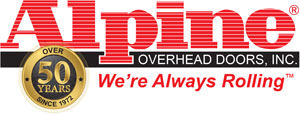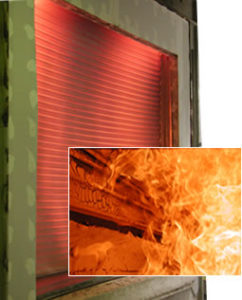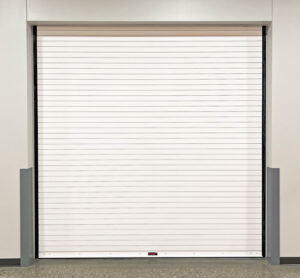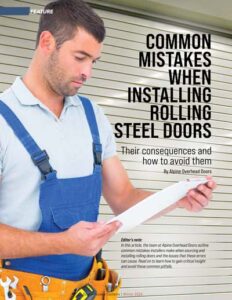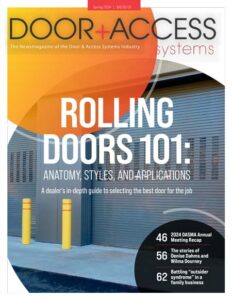Rolling fire doors serve an important purpose: to protect property by containing the spread of fire and smoke. They achieve this by closing automatically when activated in the event of a fire, and by being durable enough to withstand intense heat for a specified period of time. With all this comes a variety of features, options and certifications, which we will review today.
Activation
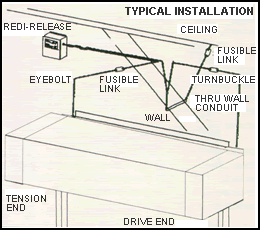 In order for a fire door to close during a fire, it must be instructed to do so. This is known as activation. The conventional method for achieving this is by using a fusible link. The principle is similar to an electric fuse. Though in this case, it’s the increase in ambient temperature that causes the link to break. Once broken, the door then knows it’s time to drop. This is a simple, cost-effective way to achieve activation, but it does come with a drawback. The door will lose tension and will need to be mechanically reset manually, and the fusible link will need to be replaced. This is typically done by a door specialist, and will require ongoing out-of-pocket expenses over the life of the door.
In order for a fire door to close during a fire, it must be instructed to do so. This is known as activation. The conventional method for achieving this is by using a fusible link. The principle is similar to an electric fuse. Though in this case, it’s the increase in ambient temperature that causes the link to break. Once broken, the door then knows it’s time to drop. This is a simple, cost-effective way to achieve activation, but it does come with a drawback. The door will lose tension and will need to be mechanically reset manually, and the fusible link will need to be replaced. This is typically done by a door specialist, and will require ongoing out-of-pocket expenses over the life of the door.An alternative approach for activation is known as auto-reset. With this method, an event triggers the door to drop. This includes power failure, a fire alarm signal, break of a fusible link, or True-Test activation. When triggered, both the centrifugal governor and constant hold breaks release. Note that auto-reset doors do not lose tension after testing/activation. As a result, they do not need to be mechanically reset, thus eliminating recurring resetting costs. Though systems that use fusible links will still need them replaced if blown.
Auto reset fire doors require operators that are specifically designed for that purpose. They may be operated by motor, hand chain or hand crank.
A release device allows for time delaying, alarm tie ins or failsafe functionality. The release device may be a separate component, or built into the operator itself.
Certifications and Approvals for Fire Rated Rolling Doors
 Fire rated doors are regulated by a variety of agencies, regional, national and global. Requirements typically include routine testing and other measures to help ensure that the door will perform as expected if needed.
Fire rated doors are regulated by a variety of agencies, regional, national and global. Requirements typically include routine testing and other measures to help ensure that the door will perform as expected if needed.
Certifications of fire doors to certain performance specifications are managed by multiple entities such as UL, Factory Mutual (FM), and local/regional bodies.
UL listings and certifications generally cover how long the door may remain in-tact during a fire event, based on testing. These include ratings of 4, 3, 1-1/2, 1, and ¾ hours, or 30 or 20 minutes.
FM approvals are awarded to products that meet or exceed their rigorous standards of quality and performance. They provide testing and certification services that are recognized worldwide.
Local municipalities may maintain additional guidelines and approvals. For instance, New York City has Materials and Equipment Acceptance (MEA), requiring that fire doors meet their specific guidelines before being approved.
Fire Door Inspecting and Testing
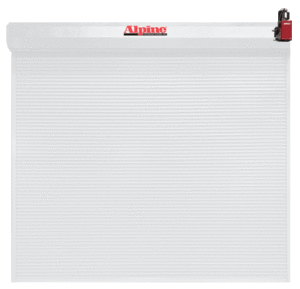 Annual inspection and testing of a fire door is mandated to make sure the door is functioning as it should. The National Fire Protection Association Publication 80 (NFPA 80) details the requirements. It is the responsibility of the property owner or manager. The test must be done by a qualified individual. They are required do a visual inspection, confirm all methods operation, and perform a drop test and reset.
Annual inspection and testing of a fire door is mandated to make sure the door is functioning as it should. The National Fire Protection Association Publication 80 (NFPA 80) details the requirements. It is the responsibility of the property owner or manager. The test must be done by a qualified individual. They are required do a visual inspection, confirm all methods operation, and perform a drop test and reset.Insulated, and Storm/Wind Rated Rolling Fire Doors
For areas that are prone to high wind loads due to hurricanes and other intense weather conditions, fire rated rolling storm doors may be used. They typically contain stronger slats, windlocks and windbars, structural steel angles and other features designed to keep the door intact when subjected to strong winds. Rolling storm doors are subject to additional certifications such as Dade County and Florida Building Commission, which maintains the Florida Building Code. Insulated curtains are also available for applications requiring thermal or sound protection.Smoke Rating and Labeling
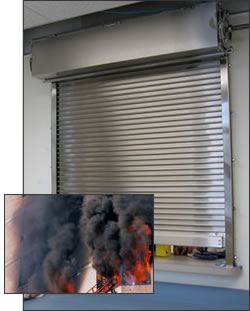 Certain situations require smoke rating and labeling. To achieve a smoke rating, doors are outfitted with smoke seals around the perimeter, which includes the guides, and bottom bar. These seals stop smoke from passing through and spreading.
Certain situations require smoke rating and labeling. To achieve a smoke rating, doors are outfitted with smoke seals around the perimeter, which includes the guides, and bottom bar. These seals stop smoke from passing through and spreading.Specialty Fire Rated Doors
Specialty applications such as marine bulkheads, oil drilling platforms or chemical storage and other maritime applications require additional considerations, such as being able to withstand challenges including winds, corrosion and hydorcarbon pool fires.Other options on rolling fire doors include various lock styles, powder coating, access controls and obstruction sensors. Also not that larger size doors require a Classified UL label marked “OVERSIZE ROLLING STEEL FIRE DOOR” that includes the hourly rating as well as the certification number.
